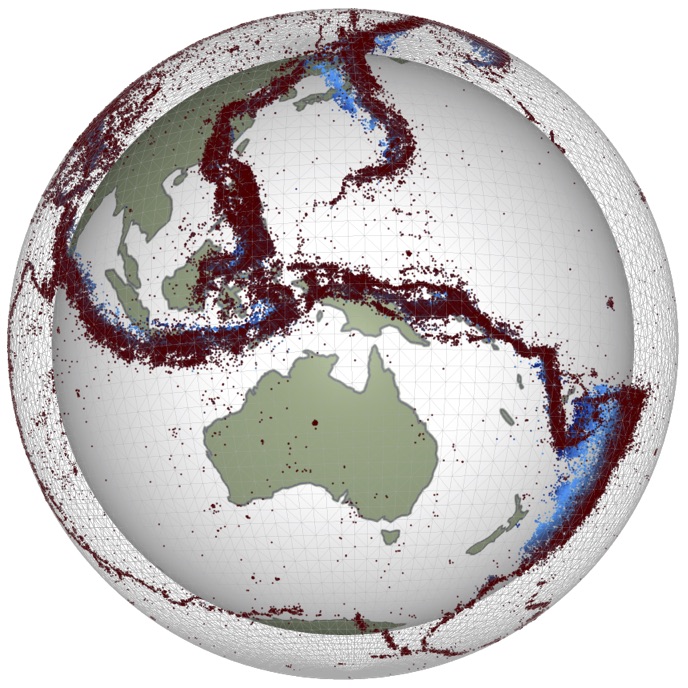Poisson Equation (simple)#
First we show how this works using the generic class and then the minor differences for
the Poisson class
Generic scalar solver class#
# to fix trame issue
import nest_asyncio
nest_asyncio.apply()
from petsc4py import PETSc
import os
os.environ["UW_TIMING_ENABLE"] = "1"
import underworld3 as uw
from underworld3 import timing
import numpy as np
import sympy
from IPython.display import display
mesh1 = uw.meshing.UnstructuredSimplexBox(
minCoords=(0.0, 0.0), maxCoords=(1.0, 1.0), cellSize=1.0 / 4, refinement=4
)
mesh2 = uw.meshing.UnstructuredSimplexBox(
minCoords=(0.0, 0.0),
maxCoords=(1.0, 1.0),
cellSize=1.0 / 4,
regular=True,
refinement=4,
)
# pick a mesh
mesh = mesh1
phi = uw.discretisation.MeshVariable("Phi", mesh, 1, degree=2, varsymbol=r"\phi")
scalar = uw.discretisation.MeshVariable(
"Theta", mesh, 1, degree=1, continuous=False, varsymbol=r"\Theta"
)
Create Poisson object
poisson = uw.systems.Poisson(mesh, u_Field=phi, solver_name="diffusion")
Constitutive law (diffusivity)
poisson.constitutive_model = uw.constitutive_models.DiffusionModel
poisson.constitutive_model.Parameters.diffusivity = 1
# %%
poisson.constitutive_model.c
# Set some things
poisson.f = 0.0
poisson.add_dirichlet_bc(1.0, "Bottom", components=0)
poisson.add_dirichlet_bc(0.0, "Top", components=0)
poisson.tolerance = 1.0e-6
poisson.petsc_options["snes_type"] = "newtonls"
poisson.petsc_options["ksp_type"] = "fgmres"
poisson.petsc_options["snes_monitor"] = None
poisson.petsc_options["ksp_monitor"] = None
poisson.petsc_options.setValue("pc_type", "mg")
poisson.petsc_options.setValue("pc_mg_type", "multiplicative")
poisson.petsc_options.setValue("pc_mg_type", "kaskade")
# poisson.petsc_options["mg_levels"] = mesh.dm.getRefineLevel()-2
poisson.petsc_options["mg_levels_ksp_type"] = "fgmres"
poisson.petsc_options["mg_levels_ksp_max_it"] = 100
poisson.petsc_options["mg_levels_ksp_converged_maxits"] = None
poisson.petsc_options["mg_coarse_pc_type"] = "svd"
poisson.view()
poisson._setup_pointwise_functions(verbose=True)
poisson._setup_discretisation()
timing.reset()
timing.start()
# %%
# Solve time
poisson.solve()
type(poisson.F1)
# %%
# Check. Construct simple linear function which is solution for
# above config. Exclude boundaries from mesh data.
import numpy as np
with mesh.access():
mesh_numerical_soln = uw.function.evalf(poisson.u.fn, mesh.data)
mesh_analytic_soln = uw.function.evalf(1.0 - mesh.N.y, mesh.data)
if not np.allclose(mesh_analytic_soln, mesh_numerical_soln, rtol=0.0001):
print("Unexpected values encountered.")
Validate
if uw.mpi.size == 1:
import pyvista as pv
import underworld3.visualisation as vis
pvmesh = vis.mesh_to_pv_mesh(mesh)
pvmesh.point_data["T"] = mesh_analytic_soln
pvmesh.point_data["T2"] = mesh_numerical_soln
pvmesh.point_data["DT"] = pvmesh.point_data["T"] - pvmesh.point_data["T2"]
pl = pv.Plotter(window_size=(750, 750))
pl.add_mesh(
pvmesh,
cmap="coolwarm",
edge_color="Black",
show_edges=True,
scalars="DT",
use_transparency=False,
opacity=0.5,
# scalar_bar_args=sargs,
)
pl.camera_position = "xy"
pl.show(cpos="xy")
# pl.screenshot(filename="test.png")
Create some arbitrary function using one of the base scalars x,y[,z] = mesh.X
import sympy
x, y = mesh.X
x0 = y0 = 1 / sympy.sympify(2)
k = sympy.exp(-((x - x0) ** 2 + (y - y0) ** 2))
poisson.constitutive_model.Parameters.diffusivity = k
poisson.constitutive_model.flux
with mesh.access():
orig_soln = poisson.u.data.copy()
orig_soln_mesh = uw.function.evalf(phi.sym[0], mesh.data)
# %%
poisson.solve(zero_init_guess=True, _force_setup=True)
print(poisson.Unknowns.u.stats())
Simply confirm results are different
with mesh.access():
if np.allclose(poisson.u.data, orig_soln, rtol=0.001):
raise RuntimeError("Values did not change !")
mesh._evaluation_hash = None
Visual validation
if uw.mpi.size == 1:
import pyvista as pv
import underworld3.visualisation as vis
pvmesh2 = vis.mesh_to_pv_mesh(mesh)
pvmesh2.point_data["T"] = uw.function.evaluate(phi.sym[0], mesh.data)
pvmesh2.point_data["Te"] = uw.function.evalf(phi.sym[0], mesh.data)
pvmesh2.point_data["dT"] = pvmesh2.point_data["T"] - pvmesh.point_data["T"]
pvmesh2.point_data["dTe"] = pvmesh2.point_data["T"] - pvmesh2.point_data["Te"]
pl = pv.Plotter(window_size=(750, 750))
pl.add_mesh(
pvmesh2,
cmap="coolwarm",
edge_color="Black",
show_edges=True,
scalars="dT",
use_transparency=False,
opacity=0.5,
# scalar_bar_args=sargs,
)
pl.camera_position = "xy"
pl.show(cpos="xy")
# pl.screenshot(filename="test.png")
Non-linear example#
RHS term
abs_r2 = x**2 + y**2
poisson.f = -16 * abs_r2
poisson.add_dirichlet_bc(abs_r2, "Bottom", components=0)
poisson.add_dirichlet_bc(abs_r2, "Top", components=0)
poisson.add_dirichlet_bc(abs_r2, "Right", components=0)
poisson.add_dirichlet_bc(abs_r2, "Left", components=0)
display(poisson.f)
Constitutive law (diffusivity) Linear solver first
poisson.constitutive_model = uw.constitutive_models.DiffusionModel
poisson.constitutive_model.Parameters.diffusivity = 1
poisson.solve()
Non-linear diffusivity
grad_phi = mesh.vector.gradient(phi.sym)
k = 5 + (grad_phi.dot(grad_phi)) / 2
poisson.constitutive_model.Parameters.diffusivity = k
poisson.constitutive_model.c
# %%
poisson._setup_pointwise_functions()
poisson._G3
Use initial guess from linear solve
poisson.solve(zero_init_guess=False)
Validate
if uw.mpi.size == 1:
import pyvista as pv
import underworld3.visualisation as vis
pvmesh2 = vis.mesh_to_pv_mesh(mesh)
pvmesh2.point_data["T"] = vis.scalar_fn_to_pv_points(pvmesh2, phi.sym)
pl = pv.Plotter(window_size=(750, 750))
pl.add_mesh(
pvmesh2,
cmap="coolwarm",
edge_color="Black",
show_edges=True,
scalars="T",
use_transparency=False,
opacity=0.5,
# scalar_bar_args=sargs,
)
pl.camera_position = "xy"
pl.show(cpos="xy")
# pl.screenshot(filename="test.png")
Analysis (Gradient recovery)#
We’d like to be able to look at the values of diffusivity or the heat flux.
These are discontinuous values computed in the element interiors but can
be projected to a meshVariable:
# %%
projection = uw.systems.Projection(mesh, scalar)
projection.uw_function = sympy.diff(phi.sym[0], mesh.X[1])
projection.smoothing = 1.0e-4
projection.solve()
with mesh.access():
print(phi.stats())
print(scalar.stats())
# %%
sympy.diff(scalar.sym[0], mesh.X[1])
Validate
if uw.mpi.size == 1:
import pyvista as pv
import underworld3.visualisation as vis
pvmesh2 = vis.mesh_to_pv_mesh(mesh)
pvmesh2.point_data["K"] = vis.scalar_fn_to_pv_points(pvmesh2, scalar.sym)
pvmesh2.point_data["T"] = vis.scalar_fn_to_pv_points(pvmesh2, phi.sym)
pl = pv.Plotter(window_size=(750, 750))
pl.add_mesh(
pvmesh2,
cmap="coolwarm",
edge_color="Black",
show_edges=True,
scalars="T",
use_transparency=False,
opacity=0.5,
# scalar_bar_args=sargs,
)
pl.camera_position = "xy"
pl.show(cpos="xy")
# pl.screenshot(filename="test.png")
poisson.snes.view()
timing.print_table()

